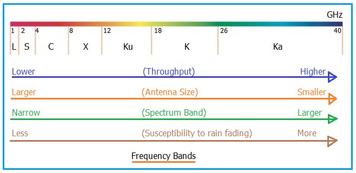Ku-Band vs. C-Band VSAT: Advantages and Disadvantages
Advertisement
This article discusses the pros and cons of Ku-band and C-band VSAT systems, highlighting the differences between these two types of VSAT (Very Small Aperture Terminal) technologies.
Understanding VSAT and Satellite Communication
Before diving into the specifics of Ku-band and C-band, it’s helpful to understand the basics of satellite communication and VSAT systems. (Refer to a satellite tutorial covering topics like satellite bands, orbits, services, types, capacity allocations, network configurations, applications, remote sensing, and VSAT basics for a comprehensive understanding).
Ku-Band VSAT
The Ku-band refers to the frequency range of 12.5 GHz to 18 GHz. A VSAT system operating within this frequency band is known as a Ku-Band VSAT.
- Up Link Frequency: 14 to 14.5 GHz
- Down Link Frequency: 10.95 to 11.7 GHz
C-Band VSAT
The C-band covers the frequency range of 4 to 8 GHz. A VSAT system operating within this band is known as a C-Band VSAT.
- Up Link Frequency: 5.925 to 6.425 GHz
- Down Link Frequency: 3.7 to 4.2 GHz
Ku-Band VSAT vs. C-Band VSAT: Merits and Demerits
The following table summarizes the key differences, advantages, and disadvantages of Ku-band and C-band VSAT systems:
| Feature | Ku-Band VSAT | C-Band VSAT |
|---|---|---|
| Merits (Benefits) | • Allows the use of smaller dish antennas. • High transponder power is available. • Experiences less terrestrial interference. | • Signals are less susceptible to rain fading. Attenuation is in the range from 0.4 to 1 dB only. • High transponder power is widely available. • Wider and even global beam coverage. This results in more C-band VSATs covered by a C-Band Satellite. |
| Demerits (Drawbacks) | • Signals are susceptible to fading during rain. Attenuation is in the range from 6 to 10 dB. • High transponder power is not available everywhere. • Narrower beam coverage, hence less coverage area. This results in less Ku-band VSAT coverage by a Ku-band Satellite. | • Needs slightly larger dishes compared to Ku-band. • Needs lower transponder power for operation. • Higher likelihood of terrestrial interference. |
Advertisement
 RF
RF






